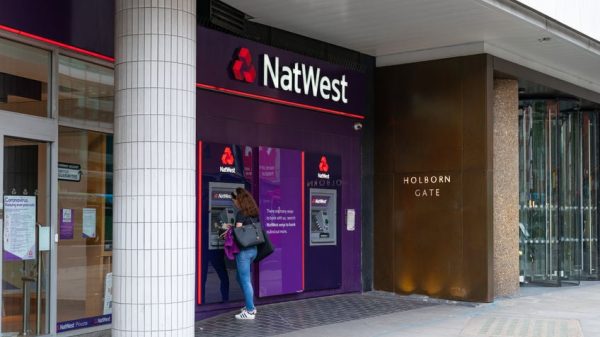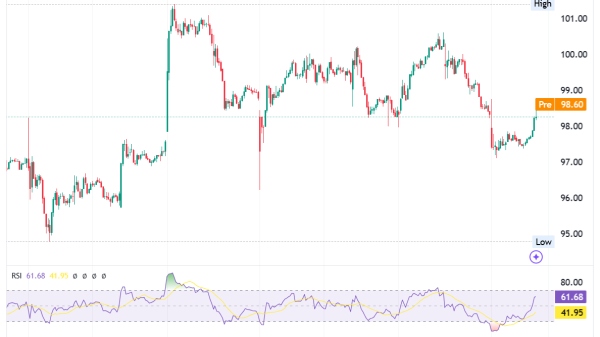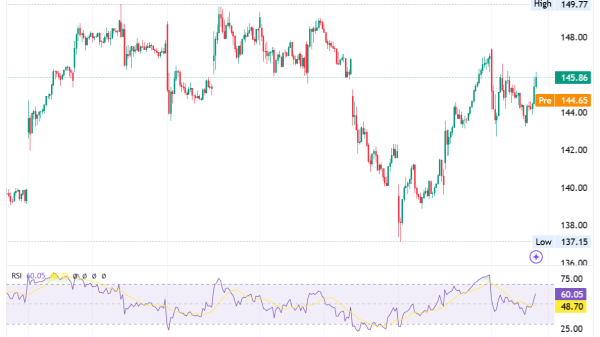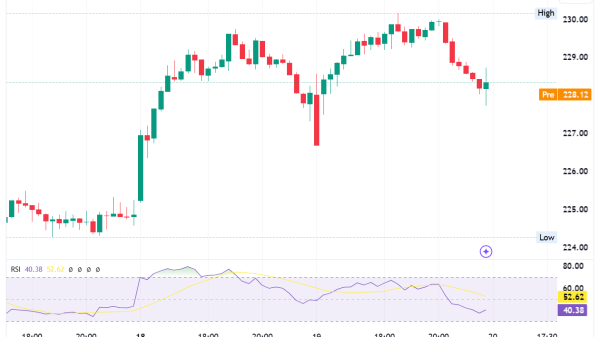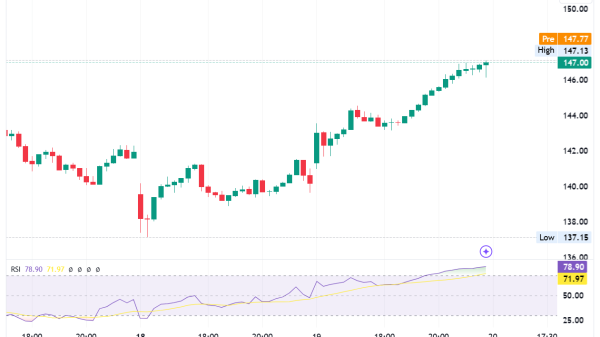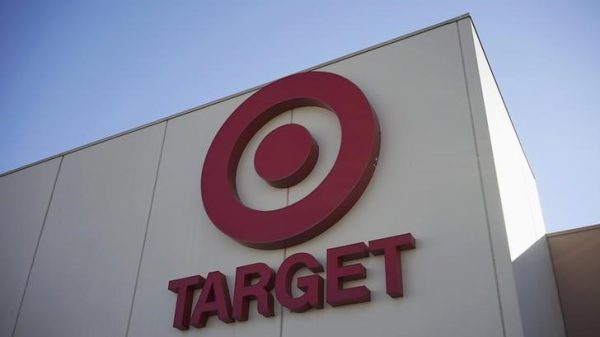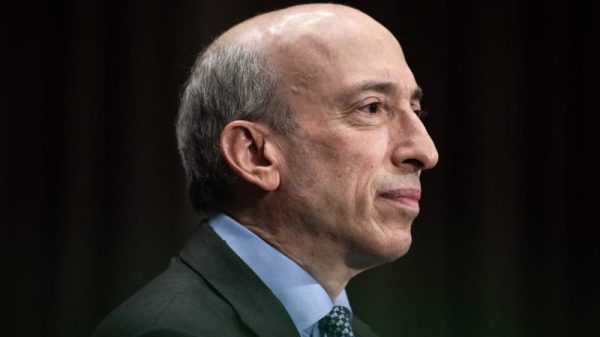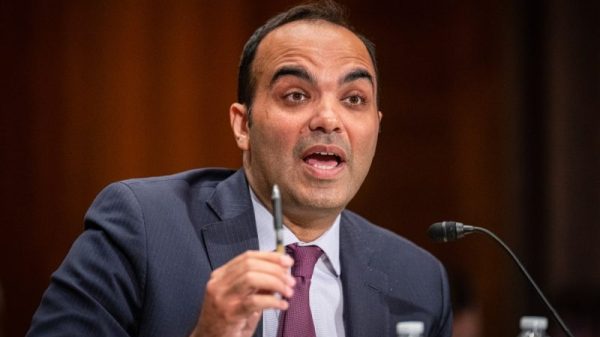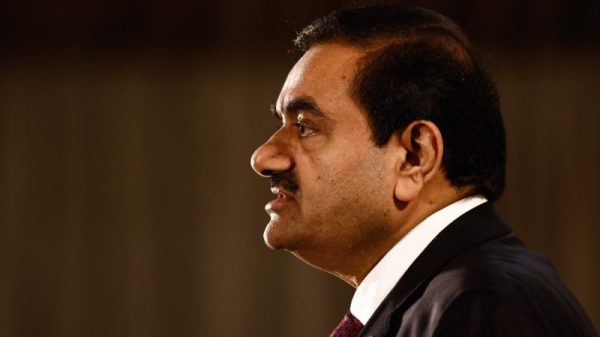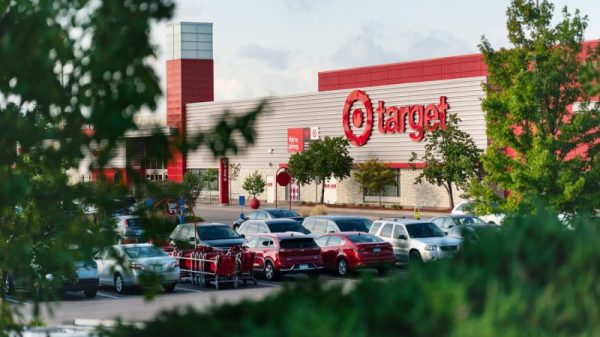
In the third quarter of 2024, AT&T (T) delivered solid financial performance, with significant growth in high-value wireless and broadband subscribers. The company added 403,000 postpaid phone subscribers and saw a 6% EBITDA growth in its Mobility segment. Despite a work stoppage and the impact of Hurricane Helene, AT&T reported positive broadband subscriber growth, including 226,000 AT&T Fiber net adds. Total revenues stood at $29 billion, a slight decrease from the previous year, primarily due to reduced vendor financing payments. Capital expenditures increased to $5.3 billion, reflecting the company’s commitment to wireless network modernization.
Key Takeaways
- AT&T added 403,000 postpaid phone net adds and achieved over 6% EBITDA growth in Mobility.
- The company saw 226,000 AT&T Fiber net adds, with a 17% growth in fiber revenues.
- AT&T plans to expand its fiber footprint to pass 30 million locations by the end of 2025.
- The company announced the sale of its 70% stake in DIRECTV.
- Year-to-date free cash flow reached $12.8 billion, with a full-year expectation of $17 billion to $18 billion.
- Total Q3 revenues were $29 billion, with capital expenditures of $5.3 billion.
Company Outlook
- AT&T aims to achieve a full-year capital investment between $21 billion and $22 billion.
- The company is tracking free cash flow to the midpoint of the guided range of $17 billion to $18 billion.
- Management expressed confidence in meeting the full-year financial guidance.
Bearish Highlights
- Business Wireline EBITDA fell by 20% due to declines in legacy voice services.
- Total revenues decreased slightly year-over-year by $150 million.
Bullish Highlights
- Mobility service revenue grew by 4%, with an EBITDA increase of 6.7% to $9.5 billion.
- Consumer Wireline EBITDA grew by 8.6%, supported by a 6.4% increase in broadband revenues.
- The company reduced net debt by $1.1 billion in Q3.
Misses
- The number of postpaid phone subscribers added was down from 468,000 a year prior.
Q&A Highlights
- AT&T is not interested in acquiring HFC assets and is focusing on organic growth.
- Adjustments in pricing actions will impact postpaid phone ARPU in the fourth quarter.
- The company is open to exploring secondary market opportunities for spectrum acquisition.
- Investments are aimed at sustaining EBITDA growth and improving profit margins, especially in the Consumer broadband segment.
AT&T’s leadership, including CEO John Stankey, emphasized the strategic focus on fiber infrastructure and the potential for wholesale opportunities in the future. The company’s shift toward a connectivity-based business model and the divestiture of DIRECTV are indicative of its commitment to 5G and fiber connectivity. With the Analyst and Investor Day scheduled for December 3, 2024, further updates on AT&T’s strategic plans are anticipated.
InvestingPro Insights
AT&T’s solid third-quarter performance is reflected in its current market position and financial metrics. According to InvestingPro data, AT&T boasts a substantial market capitalization of $159.82 billion, underscoring its status as a major player in the telecommunications industry. This aligns with the InvestingPro Tip highlighting AT&T as a “prominent player in the Diversified Telecommunication Services industry.”
The company’s P/E ratio of 14.36, which drops to 11.16 when adjusted for the last twelve months, suggests that AT&T’s stock may be undervalued relative to its earnings. This could be particularly interesting for value investors, especially considering the company’s strong recent performance in key areas such as Mobility and Fiber.
AT&T’s dividend yield of 5.16% is noteworthy, especially in light of the InvestingPro Tip that the company “has maintained dividend payments for 41 consecutive years.” This long-standing commitment to shareholder returns aligns with the company’s reported free cash flow of $12.8 billion year-to-date and its projection of $17-18 billion for the full year.
The company’s revenue for the last twelve months stands at $122.2 billion, with a gross profit margin of 59.61%. These figures support AT&T’s ability to generate substantial cash flow and maintain its dividend payments, which is crucial for income-focused investors.
Interestingly, AT&T’s stock has shown strong performance recently, with a 19.58% price total return over the last three months and an impressive 52.7% return over the past year. This aligns with the InvestingPro Tip noting a “strong return over the last three months” and “high return over the last year.” The stock is currently trading at 99.42% of its 52-week high, further supporting the tip that it is “trading near 52-week high.”
For investors seeking more comprehensive analysis, InvestingPro offers additional tips and insights. Currently, there are 12 more InvestingPro Tips available for AT&T, providing a deeper understanding of the company’s financial health and market position.
Full transcript – AT&T (T) Q3 2024:
Operator: Thank you for standing by. Welcome to AT&T’s Third Quarter 2024 Earnings Call. At this time, all participants are in a listen-only mode. [Operator Instructions] Following the presentation, the call will be open for questions. [Operator Instructions] And as a reminder, this conference is being recorded. I would like to turn the conference over to our host, Brett Feldman, Senior Vice President of Finance and Investor Relations. Please go ahead.
Brett Feldman: Thank you, and good morning. Welcome to our third quarter call. I’m Brett Feldman, Head of Investor Relations for AT&T. Joining me on the call today are John Stankey, our CEO; and Pascal Desroches, our CFO. Before we begin, I need to call your attention to our safe harbor statement. It says that some of our comments today may be forward-looking. As such, they’re subject to risks and uncertainties described in AT&T’s SEC filings, results may differ materially. Additional information as well as our earnings materials are available on the Investor Relations website. With that, I’ll turn the call over to John Stankey. John?
John Stankey: Thank you, Brett. I appreciate everyone joining this morning. I hope you’re all doing well today. The third quarter showed again that our team continues to produce solid results as we efficiently grow high value wireless and broadband subscribers. Since Pascal will go through the quarter in detail, I’ll share more on how our investment led strategy is helping us deliver on our full year consolidated financial guidance, creating runway for future growth, and then I’ll provide a few updates on some recent developments. Our strategy remains the same to lead the industry in converged connectivity through 5G and fiber. In Mobility, the value of the coverage and reliability of the service we provide and our best deals for every one approach that puts our customers first are producing solid, sustainable results. We’re growing 5G subscribers in a durable way and delivered 403,000 postpaid phone net adds in the third quarter. We also grew efficiently with lower year-over-year postpaid phone churn and upgrade rates. Three quarters of the way through the year, our Mobility business has grown EBITDA by more than 6%, which is in the high end of the guidance we provided for the full year. This puts us in a solid position heading into the fourth quarter where we expect seasonally higher phone purchasing activity, upgrades and promotional cycles. Overall, we feel great about our continued momentum in Mobility. We’re adding customers, increasing profitability and expect to deliver the best postpaid phone churn in the industry for the 13th time in 15 quarters. Now let’s switch gears to Consumer Wireline where we generated positive total broadband subscriber net adds for the fifth consecutive quarter despite impacts from a one month work stoppage in the Southeast and from Hurricane Helene. And I think it’s important to take a moment, recognize our frontline teams who continue to show up in a heroic fashion while confronting multiple devastating hurricanes. We were pleased to welcome our committed employees in the Southeast back to work on September 16th, with newly ratified agreements, a five year contract in the Southeast and a similar four year agreement in the West, we appropriately recognize our employees for the exceptional service and performance they provide our customers on a daily basis with annual wage increases averaging 3.6%. Our employees will maintain their position as some of the best paid professionals in the industry, while we cooperatively work with our labor partners to reposition the company around 5G and fiber is the only all union wireless and broadband provider in the U.S. We serve millions of individuals and businesses in the Southeast region of the country and our frontline employees on the ground have responded quickly and worked tirelessly to keep our communities, customers and first responders connected when it matters most. For context, our FirstNet organization provides a meaningfully differentiated product to public safety during events like these. Our organization dedicated to supporting our growing public safety base on FirstNet responded to more than 200 requests during the Hurricane Helene recovery. This was one of our largest emergency response efforts ever. These efforts are nothing short of remarkable. It’s exactly why more than 29,000 public safety agencies and organizations, including the New York City Police Department, the Fire Department of New York City and the North Carolina Department of Public Safety choose FirstNet. The only dedicated communications platform for public safety. We applaud the FCC’s recent decision to make available 50 megahertz of spectrum to the FirstNet authority to facilitate nationwide deployment of 5G services for first responders, and we look forward to working together on plans that take these capabilities to the next level. Moving back to broadband. Despite a 30 day work stoppage in the Southeast portion of our footprint, we’ve now had more than 200,000 AT&T Fiber net adds for 19 consecutive quarters, which shows the strong underlying customer demand for fiber. In the quarter, Consumer Wireline delivered more than 8% EBITDA growth, driven by nearly 17% growth in fiber revenues. These consistent results make it clear that our fiber investment is generating attractive returns with improved operating leverage as we transition from legacy networks. Overall, the underlying momentum with 5G and fiber positions us to close the year strong. While our 5G and fiber businesses are performing well on their own, it’s increasingly clear that customers prefer to purchase mobility and broadband together as a converged service. Only AT&T can offer this at scale with benefits from owners’ economics. This is driving a reinforcing cycle where the success of our fiber business drives growth in mobility and vice versa. As we shared last quarter, about four out of every 10 AT&T fiber households also choose AT&T is their wireless provider. Additionally, our share of postpaid phone subscribers within the AT&T fiber footprint is about 500 basis points higher than our national average. This highlights the true benefit of owning and operating both 5G and fiber networks at scale, which is the ability to drive higher share in both mobility and broadband through converged service penetration. Over time, we expect this should drive higher returns on our invested capital in both our mobility and broadband businesses than either could achieve as a standalone operation. While our convergence strategy began with a focus on our own fiber footprint, we’re also pursuing attractive opportunities to expand AT&T fiber outside of it. We’re already America’s largest fiber provider with the fastest and most reliable speeds. The superiority of AT&T fiber elevates the overall AT&T brand, we want more customers to experience the best wired Internet experience available today, that’s why we’ve announced plans to bring AT&T Fiber high speed Internet to even more people in new geographies through Gigapower, our joint venture with BlackRock (NYSE:BLK), as well as through recent agreements with commercial open access fiber providers. These fiber driven growth initiatives present attractive capital efficient ways for us to provide both AT&T fiber and 5G wireless services to more customers. In addition to being the largest capital investor in the U.S. connectivity infrastructure since 2019 we continue to reduce our net debt and increase operating leverage due to a combination of higher EBITDA and strong free cash flow generation. Our financial flexibility continues to improve, and we remain on pace to meet our target of net debt to adjusted EBITDA in the 2.5 times range in the first half of next year. In the quarter, we also announced that we reached an agreement to sell our remaining 70% stake in DIRECTV to TPG in a non-contingent transaction, subject only to customary closing conditions, and separate from the regulatory process associated with the DIRECTV DISH transaction. This sale and transaction structure allows us to continue our focus on being a leader in 5G and fiber connectivity throughout America, while further strengthening the balance sheet. It also presents new optionality as we consider opportunities to leverage our significant distribution to aggregate products and services that simplify and improve our customers’ lives. We will close the transaction following necessary regulatory approvals and optimal financing and tax considerations. We’re confident that the company’s transformation over the past four years has positioned us well for continued organic growth, while also increasing our financial flexibility and capacity to support sustained investment and enhance shareholder returns. We’re excited to share the details of what this all means for the future of AT&T, when we speak with you again at our upcoming Analyst and Investor Day on December 3rd, so mark your calendars for an exciting visit to Big D. With that, I’ll turn it over to Pascal to cover the quarter in greater detail. Pascal?
Pascal Desroches: Thank you, John, and good morning, everyone. Let’s start by reviewing our third quarter financial summary on Slide 8. Third quarter consolidated results were in line with our expectations. Revenues were down slightly as a decline in Business Wireline service revenues and low margin mobility equipment revenues were mostly offset by growth in higher margin wireless service revenues and fiber revenues. Year-over-year consolidated revenue trends were also impacted by more than $100 million of FX headwinds and an approximately $100 million impact from transferring our cybersecurity business into a joint venture earlier this year. Adjusted EBITDA was up 3.4% for the quarter as growth in Mobility, Consumer Wireline and Mexico, which collectively drove more than 80% of our total revenues in the quarter were partially offset by a continued decline in Business Wireline. Year-to-date, adjusted EBITDA grew 3.4%, and we continue to expect adjusted EBITDA growth in the 3% range for the full year. We expect to achieve this growth even with about $115 million of estimated financial impact related to the effects of Hurricane Helene and Milton and the work stoppage. Consumer Wireline and Business Wireline are expected to bear most of this impact. Adjusted EPS was $0.60 compared to $0.64 in the year-ago quarter. Consistent with prior quarters this year, the third quarter included about $0.09 of aggregate EPS headwinds from the four items we discussed earlier in the year. Adjusted EPS excludes $0.61 impact related to a $4.4 billion non-cash goodwill impairment charge for our Business Wireline unit driven by an industry-wide secular decline of legacy services. For the full year, our expectations remain for adjusted EPS in the range of $2.15 to $2.25. Year-to-date, free cash flow is $12.8 billion. This is up $2.4 billion compared to the same time last year and consistent with our goal of driving higher free cash flow that is more ratable on a quarterly basis. In the third quarter, we generated free cash flow of $5.1 billion, which included the previously disclosed one-time payment of $480 million related to our wireless network transformation and the continued paydown of vendor financing obligations. Capital investment for the quarter was $5.5 billion, down about $150 million compared to the prior year, primarily due to lower vendor financing payments. Capital expenditures were $5.3 billion, up approximately $650 million compared to the prior year. We expect higher capital investment in the fourth quarter as we ramp our wireless network modernization. We also expect to sustain strong cash conversion in the fourth quarter and anticipate using our improved liquidity to continue reducing our short-term financing, including further paydown of vendor financing in the fourth quarter. These additional vendor financing payments put us on page for a full year capital investment at the high end of our guidance range of $21 billion to $22 billion. Our free cash flow is tracking to the midpoint of our guidance range of $17 billion to $18 billion. Now let’s look at our mobility operating results on Slide 9. For the quarter, we delivered 403,000 postpaid phone net adds down from 468,000 a year ago. This is consistent with our wireless market normalization expectation. We also posted another quarter of year-over-year churn improvement with postpaid phone churn of 0.8% versus 0.79% in the third quarter of 2023. Mobility service revenue grew 4% driven by strong execution in our balanced go-to-market strategy. In the quarter, we also aligned the timing of certain administrative fees and recorded approximately $90 million of one-time revenues that benefited service revenue. Postpaid phone ARPU was $57.7, up 1.9% year-over-year largely driven by higher ARPU on legacy plans. As expected, service revenue growth was partially offset by lower equipment revenues with a postpaid upgrade rate of 3.5%, which was down from 3.9% last year. In prepaid, our Cricket brand continues to display remarkable consistency with positive phone net adds for 40 consecutive quarters or a decade straight. For the year, we continue to expect Mobility service revenue growth in the 3% range. Mobility EBITDA of $9.5 billion grew 6.7% or by about $600 million year-over-year. On a year-to-date basis, Mobility EBITDA grew 6.3%, reflecting nearly 100% of service revenue growth flowing through to EBITDA. The strong performance puts us on pace to achieve our target of mobility EBITDA growth in the higher end of the mid-single digit range for the full year. Our Mobility outlook also continues to anticipate higher fourth quarter promotional activity levels consistent with seasonal trends. Now let’s move to Consumer Wireline results on Slide 10. The sustainable strength of fiber is driving Consumer Wireline growth and yielding strong returns. In the quarter, we added 28,000 total broadband subscribers, which includes 226,000 AT&T fiber net adds. Our fiber subscriber gains also reflect an estimated 50,000 fewer net adds from the work stoppage and storms in the Southeast. It is clear that where we do have AT&T Fiber, we win. We now passed more than 28 million consumer and business locations with fiber and remain on track to pass 30 million plus fiber locations by the end of 2025. As we’ve stated before, the better-than-expected returns we’re seeing on our fiber investment, potentially expand our opportunity to go beyond our initial build target by roughly 10 million to 15 million additional locations. We look forward to providing you with a more detailed update on our plans for expanding the reach of AT&T Fiber during our Analyst and Investor Day on December 3. Outside of fiber, we remain encouraged by the early performance of AT&T Internet Air and our success proactively migrating legacy copper-based Internet customers to this service. We now have nearly 500,000 total AT&T Internet Air consumer subscribers, including 135,000 added during the quarter. Third quarter broadband revenues grew 6.4% due to strong fiber revenue growth of nearly 17%. For the full year, we continue to expect broadband revenue growth of 7% plus. Fiber ARPU of $70.36 was up 3.2% year-over-year with intake ARPU approximately $75. We continue to see solid uptake in higher speed fiber tiers and a healthy underlying pricing trends. The third quarter also was the first full quarter in which ARPU was impacted by the rollout of Autopay changes. We view Autopay as a long-term benefit for customers as well as operationally for our broadband business. Consumer Wireline EBITDA grew 8.6%, as growth in broadband revenues and ongoing cost transformation continued to improve profitability. Through the third quarter, Consumer Wireline EBITDA grew 10%, and we continue to expect growth in the mid to high-single digit range for the full year, including impacts from the recent work stoppage and storms. Now let’s cover Business Wireline on Slide 11. Business Wireline EBITDA was down 20% due to continued industry wide secular declines in legacy voice services. The reported decline in EBITDA also reflects a tough comparison versus the third quarter of last year, which benefited from approximately $100 million of IP sales that did not recur in 3Q this year. Overall, Business Wireline is performing slightly below the outlook we provided in the first quarter due to lower revenue expectations, including a shift of IP sales into 2025, as well as the impact of Southeast work stoppage and impacts of Hurricanes Helene and Milton. We now expect Business Wireline EBITDA declines in the high-teens range for the full year versus our prior outlook for a mid-teen decline. While near-term declines in legacy voice revenues are likely to weigh on Business Wireline EBITDA trends for the remainder of the year, our 5G and wireless products continue to present attractive growth opportunities in business solutions. This includes sustained growth at FirstNet, which now has approximately 6.4 million total connections. Similarly, we’re excited about the potential of emerging growth products like AT&T Internet AirFit (ph) business. Now let’s move to Slide 12 for an update on our capital allocation strategy. Our approach to capital allocation remains consistent and deliberate. We’re successfully balancing efficient growth with long-term investment as we deliver converged network services to more customers, pay down debt and return value to shareholders. We also remain focused on deleveraging, we reduced net debt by about $1.1 billion in the quarter despite a $1.3 billion FX headwind related to foreign debt. Also recall we fully hedge our foreign denominated debt. So we have an offsetting FX gain recorded in other non-current liabilities on our balance sheet related to the hedges. Year-over-year, we’ve reduced net debt by approximately $2.9 billion and have lower vendor and supplier financing by $2.4 billion. At the end of September, net debt to adjusted EBITDA was at 2.8 times, and we’re making steady progress on achieving our target in the 2.5 times range in the first half of 2025. Looking forward, our debt maturities are very manageable and we’re in a great position with more than 95% of our long-term debt fixed with a weighted average rate of 4.2%. In addition to paying down debt, we reduced direct supplier and vendor financing obligations by about $1.7 billion versus the second quarter. The third quarter net impact from securitization facilities was a $400 million source of cash. So the net of these items was a $1.3 billion use of cash. In the fourth quarter, we expect sequential increase in direct supplier financing balances due to typical seasonality. However, we expect to continue reducing our aggregate net balance of direct supply and vendor financing on a year-over-year basis for the remainder of the year, which should lower our interest expense and continue to improve the quality and ratability of our cash flows over time. DIRECTV distributions in the quarter were about $600 million on a pretax basis. Based on the terms of our agreement to divest our 70% stake in DIRECTV, we expect $1.1 billion of pre-tax cash payments in 4Q. Cash taxes were about $600 million in the third quarter, and we expect to pay about $1.6 billion in cash taxes in the fourth quarter. To close, I’m very pleased with our team’s performance so far this year. And as John noted, we’re on pace to deliver on all of our full year 2024 consolidated financial guidance. Brett, that’s our presentation. We’re now ready for the Q&A.
Brett Feldman: Thank you, Pascal. Operator, we are ready to take the first question.
Operator: Thank you. And that will come from the line of Simon Flannery with Morgan Stanley.
Simon Flannery: Good morning. Thank you very much. John, you mentioned in the fourth quarter, we expect seasonally higher phone purchasing activity upgrades and promo cycles. Can you just put some context around that you’ve continued to see low upgrade activity. There’s concerns about a bigger iPhone cycle. What are you expecting in the fourth quarter and longer term as Apple (NASDAQ:AAPL) introduces AI, etc. And then just one on the Business Wireline. Any kind of light at the end of the tunnel there? How much more of the sort of pressures do you think we get before the rate of change starts to stabilize and improve? Thanks.
John Stankey: Hi, Simon. Good morning.
Simon Flannery: Good morning.
John Stankey: So I don’t know that I can give you an answer that’s more satisfying than last quarter on projecting what Apple phone sales might be. You’ve seen the numbers, they’re down slightly over last year’s levels on an introduction. We’re still waiting, obviously, for the software release and whether or not that software release drives interest in the consumer base to accelerate that remains to be seen, I don’t know. I’ve given you my point of view that says, I think some of these things are going to be a little bit more graceful ramp-up in consumer interest as opposed to a big bang. Software oftentimes tends to be that. If you went back and thought about any software innovation that occurs on a handset over the past decades or so, you tend to see that dynamic occur. They become material and meaningful over time. But oftentimes, certain features didn’t exactly go to this massive ramp when they’re first released because software is an iterative technology sometimes has to be iterated on to improve it and make it meaningful and address the particular need. So I don’t know that I would expect when the software release comes out, that all of a sudden, we see this massive uptick, but the consumer will ultimately decide that the consumer will be the one that decides what to do. And I think to my remarks, we’re in a position in what we’ve done through the first-three quarters of this year that we’ve got a lot of flexibility. We can adjust to whatever takes place. I think I mentioned last quarter when we were on the call, expected that fourth quarter might be active combination of holiday season device capabilities. And so we’ve tried to make sure that we’re in a position to address that, no matter how it occurs, and I feel like based on what you’ve seen in the industry over the course of the last couple of weeks, things have been very realistic and very pragmatic about how folks have approached the market. And I don’t expect things to be dramatically different as we move through the fourth quarter. Relative to Business Wireline, look, there’s a lot — there are green shoots. As you know, we’re trying to reposition the business to a connectivity based business. And when I look at what we’re doing in our connectivity based product and service portfolio as we reposition the focus of the organization, we move from spending most of our time in the Fortune 1000 to a broader exposure to the business market. I do see those volumes starting to take off, and I see our distribution starting to ramp. They’re just not doing at the rate and pace of some of the decline in the legacy revenue base and some of those are products are fairly mature products that have very attractive margin constructs around it, and there’s a little bit of a shift going on. And it’s not a whole lot different than what we were kind of going through on the consumer side a few years back. We will catch it exactly the date that we will catch it. We’ll spend some time on that in December, giving you a little bit of an outlook of how we see that playing through. But as you’ve been seeing, we’ve been doing a nice job as a business, finding other places to grow to kind of offset that as we move through it. I drive home at night thinking about a lot of things. We have a tough challenge in front of us on or things that I wonder whether we’re headed in the right direction. One thing I do not wonder about is whether we should be putting our time and effort in repositioning the business. I feel very, very comfortable that this is a place that AT&T should be, this is an important market to us, all of our data, all of our research, everything we’re doing suggests that we can create long-term value, just like we’re doing in Consumer, as a converged provider and we will be successful in that transition. And I don’t want to lose the fact that because we report Business Wireline separately, it doesn’t really reflect how we’re doing in the business market overall. When you add in what we’re experiencing in the wireless space and the solid growth that we’re putting up on the board, a lot of that’s coming from business. And it’s just — it’s a technology shift in some cases, a business that have traditionally purchase wireline services that are now migrating certain products and services to wireless. And I think our product portfolio is now starting to evolve where on a combined basis, we can be even more effective. And I’m pretty confident, we’re going to make that pivot, and we’re going to be in a good place after we get everything lined up on that.
Simon Flannery: Great. Thanks, John.
Brett Feldman: We’ll take our next question, please.
Operator: And we’ll go to the line of John Hodulik with UBS.
John Hodulik: Great. Thanks and good morning, guys. I don’t want to jump in too much on the December event, but can we talk a little bit about the out-of-region opportunity with fiber. I guess, first, how did you guys or what was the criteria for selecting the partners that you have? And are there more partners likely to be added? Second, how big could that opportunity be? I guess, including Gigapower. And third, are you guys seeing the churn benefits, I guess, you sort of laid out the customers that have bundled service, but are you guys seeing churn benefits in the wireless business for customers that — have that take both services? Thanks.
John Stankey: Hi, John. So happy to talk about some of those. And of course, to your point, we’ll spend even more time and give you a little bit more texture when you come and visit us here in December. I hope you do come. So look, the partner dynamic is — it’s a good question, and it’s really important in our point of view. And I think I alluded to this at the Communacopia conference. We tried to put a portfolio of capabilities together that make us the attractive partner. And it’s not just that we can go in and move product for somebody. We’re doing all the things where — because we have a Gigapower offer and because we’re actually, in some cases, operating what could ultimately be an open access network in some parts of the country. We’ve been very mindful of how you should construct the product offer or how you need to work with partners, etc., and we walked in with a model that’s a model that we’re executing in our own partner footprint where we can walk in and offer them even though we’re not funding the build in this case, the same construct of what we’re executing in Gigapower, same product offer, the same ability to bring our distribution strength that comes in play. The same ability to do things like offer OSS and BSS back offices that can facilitate people and how they operate things even going as far as what we can do to give them opportunities to ride on our scale and our capabilities with third-party suppliers and providers as they go about the work that they’re doing, and we’re very open, for example, of offering the technologies we put together for in-home technologies, how that product capability evolves over time. And to build a world-class product, that kind of scale is essential. So when we walk in and we approach a partner, and when we approach a partner, and we’re not necessarily interested in selling fixed wireless access over the top of them, that looks like a really good place for somebody to maybe invest in a relationship over time, that’s mutually productive moving forward. And is there more out there that can be done? Sure. And I think one of the things that maybe we all need to understand structurally of what’s occurring in this industry over time is, these partnerships and some of the open access arrangements will, in fact, change the percentage of the population that certain brands and converged capabilities can serve over time. And I think that will be a meaningful — not these most significant part, but it will be a meaningful part of the total addressable market that companies like AT&T can ultimately attack moving forward. So I do think it can get bigger. I think you’re seeing just the front end of it right now. As I’ve said before, I don’t believe this is a two or three year dynamic. I think this is what will the industry structure emerge to over the next decade dynamic. And that’s the play that I’m kind of focusing the business on, and I’m trying to think about as we allocate capital to ensure that over the next decade, AT&T is positioned in the right way as this industry restructures in a very different way than what we’ve seen in the previous decade. So where we are in performance, I gave a fair amount of insight to the front end of what we’re seeing with some of our partnership sales when I was out at Communacopia. I think what we can safely say is everything at the front end, customer acquisition, ARPUs, our rate of penetration, all those things, as I shared, are looking very, very similar to what’s happening in region. That’s how I would kind of sum it up. I think I also shared with you when we went and we established those partnerships, we didn’t expect that. We de-rated our business cases. We expected we’d be somewhat slower to penetration given that the brand hadn’t necessarily been in those markets. We expected that maybe we would have ARPU dynamics that we have to price differently in order to penetrate blah, blah, blah, that’s not happening. It’s looking more like the in-region business case and that only makes it more compelling. Now what we don’t know yet John is, we haven’t been in that business for two years or 18 months. So I can’t conclusively tell you that we’re going to see the same dynamic play into our wireless share perspective and our churn dynamic. But if I’m seeing the early stuff looking like what it does in region, I guess I’d step back and say, why should the back end look a lot different over time, assuming we offer the same quality product and the same execution, what we’re achieving on our more established footprint and all the operational dynamics would be that we are, in fact, executing in that way.
John Hodulik: Yeah. That make sense. Thanks for the color.
Brett Feldman: We will take the next question please.
Operator: That will come from the line of Peter Supino with Wolf Research.
Peter Supino: Hi. Good morning. Thank you. A question on consumer broadband and one on capital allocation. In Consumer broadband, your Internet Air net add growth stabilized despite your announcement that you’ve launched about 204 partial regions last quarter. And so, I wonder if you could comment on the relationship between that open for sale change and the growth path of Internet Air, just bigger picture? And then on capital allocation, on the M&A front, I wonder if you have a point of view on HFC assets on cable assets, where they could possibly be complementary to your fiber strategy depending on the region and the assets you have in place? Thanks.
John Stankey: Hi, Peter. I’m very comfortable with where we’re at on Internet Air. I don’t think you should be, as I’ve said many, many, many times, you shouldn’t expect that AT&T is going to look like some of our competitors in the industry on volume and where we’re going. We’re using it, as I’ve said before, very strategically. I’ll sell to any business customer that is well suited to the product, that’s an attractive market to us. It’s an attractive market because of what we can bring in growth in other products and services, including handsets in the account, we can justify the usage characteristics around it. You should expect as we continue to scale some of our distribution in the mid-business market that you’ll see those numbers grow as a result of that, and then use it very strategically in consumer. We’re using it as a footprint hold capability as we know we’ve got some copper customers, we can improve service levels, waiting for fiber. In some cases, we’re using it to migrate people off of copper so that we can ultimately turn down costly service areas and not have to support the legacy infrastructure that’s in place and occasionally in markets where we have surplus spectrum that we know will be in place for many, many years. And it’s really kind of a follow dynamic, and we can get the right kind of returns on it. But that rate and pace is never going to rival what you’re seeing with anybody else, and you should just assume that’s the case. I would tell you, relative to our internal projections of the product, we’re very much in line with what our expectations would have been. And I don’t think you’re going to see what I would call a demonstrative shift in the quarters moving forward. There was a time in my career where I thought I was – I at Air, at that time where I believe the pivot to HFC was the right capital allocation decision. And I think cable has demonstrated that it has been a pretty resilient and capable infrastructure that they’ve managed to get very attractive returns on. But every decision has its time in place. And my belief is, even if you kind of look at the dynamics of what’s necessary to service DOCSIS 4, we’re on this steady march that eventually fiber is moving its way to a customer. We’ve been on that March since the early 1980s when fiber introduced itself, and it’s just been on a slow March to getting closer to the customer. And I think we’re now starting to get into the final innings of that game. And so in what I would consider to be a more mature technology cycle of HFC jumping into something that ultimately ends with fiber having to show up at the customer’s home doesn’t seem like a timed — well-timed decision at this juncture. More importantly, I look at our business model and our organic opportunities that are in front of us, and I look at how we’re executing around this and I look at the future returns that are available, and I’m more interested in allocating capital to use the business model we have that I think is incredibly powerful and has a fantastic runway, a fantastic annuity stream, a durable annuity stream for investors. And so that’s where my energy is at, which is simplifying operations, having continuity, working with partners that can expand our footprint. I think that’s the play that has longevity. And I don’t subscribe to this point of view that over the long haul, that the next wave of growth in this space is somehow sub-optimal return characteristics. I just don’t believe that. I don’t see that. I don’t see that in any of the operations of our business. And I don’t see it in the way the market is structured.
Peter Supino: Thanks, John.
Brett Feldman: Thanks, Peter. We will take the next question, please.
Operator: And that will come from the line of David Barden of Bank of America.
David Barden: Hey, guys. Good morning. Thanks for taking the questions. So John, I do remember when you had Air, so you look great. So John, I wanted to ask this question, which is maybe the inverse of the Gigapower question, which is, as you think about how you’re building fiber out in your territory and as you make these new decisions about what’s coming next, is the fiber build in your territory walled garden that’s only for AT&T’s benefit and however much share you’re able to get is the share you get or is there a thought that maybe AT&T wants to be an open access provider and the parts of the market that it doesn’t access directly, you can at least participate in on a wholesale basis the way you historically were talking about maybe the wireless business and the cable relationship? And then the second question, if I could, Pascal, I think you were reiterating the guidance, the — I think I missed the line that said that 2025 earnings growth would be positive. Obviously, there’s lots of moving parts, but could you just step us through kind of the thought process on taking that out. Thank you.
John Stankey: Hi, Dave. That must be when you getting old, if you remember when I had Air, but…
David Barden: I’m.
John Stankey: The — but you look good for being old days.
David Barden: Right back at you, John.
John Stankey: Yeah. Look, as I said, I think the structure of this industry is going to evolve differently over the next decade. And the way I think about it is, there’s going to be far more differentiation that comes in overtime on what a converged offering looks like, and that differentiation will be both on product and service. And I think, if you’re — I don’t want to use the term walled garden, but if you think about owned and operated assets, our motivation would be to get the best customers that we can sell the most product to and provide the most vertical revenue capability on new products and services where our brand is the owned and operated servicing brand to that customer. And I think that’s the play that we want to be putting our time and energy on for the next year or two. And I think we’re going to be very successful in that regard, and we’re going to find very attractive customers that are interested in a very simple value proposition of working with one company, and we’re going to make sure that we get the most share that we possibly can in the market in that way, shape or form that will probably be the most profitable loyal and best customers we have. But I’ve been in this industry long enough to know that it is a high fixed cost industry, and there’s been an element of wholesale that has played in overtime in virtually every piece of infrastructure that’s been built. And will come a time where you step back and say there’s another point or two of growth or capacity that can be allocated in a way that’s different than the way it is today, and it could be done on a wholesale structure and it may be accretive to the overall returns of the business, I think it’s entirely possible that, that day could arrive. And I think it’s really important that we think about an industry structure in that regard because as people start talking about the ability to federate product and service across an industry and what footprint looks like over the course of the next decade. If you’re not thinking about the likelihood that, that could become an element of how the industry is structured. You’re missing the fact that the dynamic of how cable, for example, has federated on nationwide constructs of cooperation that you could have a much broader footprint of how you think about marketing and selling your products and services that have unique capabilities and your brand position in a way over time that can make a very strong difference in terms of profitability and return. So I won’t rule it out. I absolutely believe that over time, there may be an accretive and economic construct around it. I don’t know that time is right now, but it’s something that we should be paying attention to when you have plenty of capacity in the ground that you can continue to sell in different ways. And Pascal, if you want to talk about the earnings dynamic for ’25.
Pascal Desroches: Sure. Thanks. Hey, Dave. Thank you. I wouldn’t read too much into it except for the fact that, look, as you know, we announced our DIRECTV transaction. And we’re not quite sure when in 2025, that’s going to close. So depending upon when it closes, we may not grow EPS on a reported basis, but rest assured, on an organic basis, there is nothing to see here that we continue to expect our EBITDA and operating income to grow next year. So I feel really good about the overall performance and so it’s really all about DIRECTV and the timing close.
David Barden: All right. Thank you, both.
Brett Feldman: We will take the next question, please.
Operator: That will come from the line of Michael Rollins (NYSE:ROL) of Citi.
Michael Rollins: Thanks and good morning. Curious, if you could provide an update on the wireless competitive landscape broadly across the consumer and business verticals. And if you can unpack in a little bit more detail what’s driving the growth in postpaid phone ARPU on a year-over-year basis, and how you view the sustainability of postpaid phone ARPU growth over the next couple of years?
John Stankey: Hi, Michael. Look, I think the industry is great. I’m very comfortable with where things sit. It’s competitive. We’re having to work really hard, but I don’t look at it and say, I can’t figure it out. I can’t rationalize what people are doing. I mean I look at all the moves that competitors are making and what’s going on. And the — I think I can understand them. I think I understand what their trying to achieve. I understand what we have in terms of our long-term ability to compete against it in an effective fashion. I don’t mean to sound like a broken record. There’s some growth that’s going on in the industry that I’m not as interested in participating in as others might be. And I’ve tried to be disciplined about that. I feel good about kind of the balance of our growth to the quality of our growth. And I think over the long haul, that’s the best way to ensure that we’re returning for our shareholders, and I feel good about where we stand in that regard. And I don’t expect that is going to change dramatically, and I see consumers using more of our product every month. I see it working their ways into their lives in even more important fashions. And I think that bodes well over the long haul for what’s occurring. Business, as I mentioned earlier is a place that I think we could do better as our distribution gets fine-tuned a bit. That’s — there’s a lot of activity going on in the business market. I believe that we’re not — we’re doing well, but we’re not as good as we can be. I think there’s still some segments in the business market that we can be more present and more effective, especially, given what we’re able to do on a combined basis, the introduction of Internet Air in addition to selling voice products as well as our fiber footprint. And I don’t know that that’s any different in how the market is performing. It’s just an opportunity of where I think we can get incrementally better as we move through the year. As I think about ARPU, it’s always a combination of things. I actually would say, as I move into next year, I wouldn’t dismiss, if I was able to be a little bit more effective in the value segment of the market and that came at a plateauing of ARPU because I was getting a little bit better growth in that segment because of the mix that was occurring that wouldn’t bother me, frankly. But I would say on the embedded base of customers we have, our ARPU growth is because we’re able to get customers to say, they want to buy up and get more from us and buy other products and services that add value to that relationship, whether it would be insurance or what they’re needing to do to upgrade plans in order to get higher performance off the wireless network and more features and services that we bring in on the higher rated plans. We’ll continue to do that. We still have room to grow on that. We certainly have been very diligent as we have been in the last couple of years to look for pockets in our base of where we think there is a value mismatch, and we can possibly realign some pricing into the market, that’s helped us this year. It helped us last year, I would expect it might help us a little bit next year. So I feel like we can continue to do the right things and managing the returns and yields of our customers. But I would actually like to see us maybe do a little bit better down at the low end of the market overall. And that would naturally come at a little bit of a play on ARPU from a company that has leading ARPU in the industry.
Brett Feldman: We’ll go ahead and take our next question.
Operator: Thank you. That will come from the line of Jim Schneider with Goldman Sachs.
James Schneider: Good morning. Thanks for taking my question. If we consider the pace of your fiber net additions and broadband heading into next year, if you’re passing the same or more locations with better penetration, is there any reason to believe why those fiber net additions shouldn’t accelerate next year? And then relative to CapEx, I believe we heard from one of your competitors yesterday that CapEx is moving higher in 2025, mainly due to accelerated fiber investment. And then, obviously, this is an area where you’ve been the most vocal in your industry in terms of fiber expansion, is expect you would see the same trend in your CapEx next year?
John Stankey: Hi, Jim. I guess I would say our rate and pace of build has been more level loaded over the last several years and as we introduce new footprint, it’s been very ratable in kind of what we bring in. There’s still seasonality that occurs in our net add dynamics that are more market based around buying cycles of the consumer. I wouldn’t expect it to dramatically change as you move into next year. I don’t see anything where there’s a footprint that’s going to come in that will dramatically change that dynamic because we’ve been at a pretty steady pace of new footprint as how we brought it in. So I don’t think you should see any dramatic change in the rate and pace of what we’ve been able to do and how we’re doing it. And I can’t speak to my competitors. I can tell you, I’m well aware that we’ve been investing at the top of the industry over the last four years and that’s been necessary for us to reposition the company to where we are today and see some of the opportunities that are in front of us, and I feel very comfortable that, that investment has driven the right kind of growth. But we’ve been on that trajectory. We’ve already been doing the things that, I think I’m seeing other people starting to maybe look at and consider investing capital into. So it’s not like I’ve got to start investing in fiber. I’ve been doing it for over four years now, and we’ve had great success at it. We have a great footprint. We’re the leading provider of fiber in the market. And I think a lot of that’s in our run rate. And as we’re getting better and better and driving costs down, there’s things that we can do to start to moderate our capital intensity as we get some of these things behind us over time, and we’ll talk a little bit about that as we move into our Investor Day and how we see that playing out over the next couple of years.
James Schneider: Thank you.
Brett Feldman: We will take next question, please.
Operator: That will come from the line of Sebastiano Petti with JPMorgan.
Sebastiano Petti: Housekeeping question. I think last quarter, you pointed out that the postpaid phone ARPU should probably, you see more of an impact or more of a benefit in the fourth quarter than third quarter related to the price increase that kind of went into effect mid-3Q. Is that still the right way to kind of think about it? And relatedly, of the $90 million one-time benefit, is that within postpaid phone ARPU or is that perhaps captured somewhere else within service revenue? And then maybe, I guess, broader kind of question. I mean, John, you did talk about the 4.9 gigahertz award to FirstNet for AT&T. Obviously, I think in — at Communacopia, did kind of talk about the supply of spectrum likely influencing pricing across the industry over the next several years, an election upcoming in a few weeks here, probably not going to materially change the availability of spectrum for a few years. So just thinking about AT&T’s appetite, given your peer kind of did some transaction in the secondary market just last week? Thank you.
Pascal Desroches: Hey, Sebastiano. How are you. So in terms of our — the pricing actions that we announced, those will impact the fourth quarter, but it’s all baked into the guidance that we provided to you — the updated guidance we provided you. So we feel really good about the overall trajectory of the business. And the $90 million adjustment related to our simplification of our building of administrative fees really is — it is impacting postpaid ARPU.
John Stankey: So my comment on kind of where we are. I think about spectrum and the portfolio spectrum of the 4.9 not much differently than any other spectrum that needs to be developed. It takes time. If the FirstNet authority decides they want to deploy that in a way that is similar to how they’ve deployed Spectrum previously. It will certainly take time to have infrastructure put in place and to figure out where they wish to do that and how they want to deploy it. So I don’t think this is anything where you’ve got the same dynamic that you might have in the secondary spectrum market right now where you can acquire something, flip a switch and ultimately get capacity into your network and an opportunity to continue to grow on things. And for that very reason, of course, I’d be interested in the secondary market, and it’s something that we pay attention to and if I can go in and pick up attractive spectrum that is harmonized with our existing holdings that we can go and get additional capacity without putting more capital into the network to do things that’s a good move for our shareholders. It’s a good move for our customers. It’s a good way to sustain growth and where there’s opportunistic opportunities to do that, I always pay attention to those things. I’ll never — not examine those and understand whether or not there’s an opportunity to do that. And I think what’s important to understand and is, we’ll certainly talk about in December, we’ve worked really hard over the last four years. I think the team has done a remarkable job of improving the qualities of our cash flow. What our capital position is? Pascal talked about it in his comments, about where we are on the balance sheet. And we have latitude and flexibility to do those kinds of things, and do them strategically and carefully. And so to the extent that they present themselves, I do that. And similarly, as we work with the FirstNet authority there’s win-wins in a lot of these things. And just like there was a win-win in how we introduced their initial holdings spectrum and allowed them to get some of the product and service capability that is truly differentiated using our embedded portfolio spectrum and services that are in place, while we ultimately deployed the dedicated bands to them. I see the same opportunity presenting itself as we work through 4.9, where we can continue to give them advanced 5G services as we’re harmonizing that spectrum and putting it out in the network and allowing the next generation of unique and differentiated public safety services for FirstNet to be developed that we can both benefit from that if they choose to do that is the band manager for that spectrum.
Brett Feldman: Operator, we have time for one more question, please.
Operator: Thank you. And that will come from the line of Kannan Venkateshwar with Barclays.
Kannan Venkateshwar: Thank you. Maybe a couple on ’25. I know it’s a little early for you guys to start talking about it. But maybe if we could just understand the levers, I mean, operating leverage this year has been very high, especially on the mobility side because of upgrade rate and also churn being low, of course. So if you could just talk through maybe some of the levers next year, maybe on the cost front or maybe the price versus value dynamic? That would be helpful. And the same question on cash flow, just in terms of leverage, you — obviously, taxes will be a headwind. But when the financing in theory should be an easier comp and directly we, of course, would be depending on when the deal closes, that would be another variable. So if you could just help us think through the operating leverage side and the cash flow that would be helpful. Thank you.
Pascal Desroches: Sure thing. I’ll start, and John will probably chime in. Here’s the way I think about it, we’ve been investing because we expect to continue to grow our business over time. So you should expect a continuation of our EBITDA growth over time. And we will — our Mobility business, we’re really pleased with how we’ve been performing. And I believe that it’s one that we can sustain that. Similarly, we’re really pleased with our Consumer broadband business, and we continue to believe that there is opportunity to drive more operating levers there as we continue to scale fiber, what you should see is over time, profit margins that are much closer to some of our scale broadband competitors. And I would — we still have an opportunity across the board to continue to work on cost, whether it is costs associated with serving our customers through the use of AI, machine learning, there are plenty of opportunities there as well as we have opportunities to continue to rationalize our real estate footprint. And over time, the other benefit to think about the 2025 is the fact that, the last 2023 and 2024 will be a year that we have spent paying down vendor financing balances fairly significantly. And as we exit this year, I would expect us to be at a level that we will manage the company at overtime. So while those investments have depressed free cash flow over the last two years. We’re going to be in a position where they are not going to depress free cash flow. Going the other way, we would expect higher cash taxes and the absence of DIRECTV to help offset some of those tailwinds. But by and large, we are investing because we believe long term, this is a business that we can grow both top line and bottom line.
Brett Feldman: All right. That is the end of the call. Thank you so much, everyone, for joining us this morning.
Operator: Thank you. And ladies and gentlemen, that does conclude our conference for today. Thank you for your participation and for using AT&T Event Conferencing. You may now disconnect.
This article was generated with the support of AI and reviewed by an editor. For more information see our T&C.



